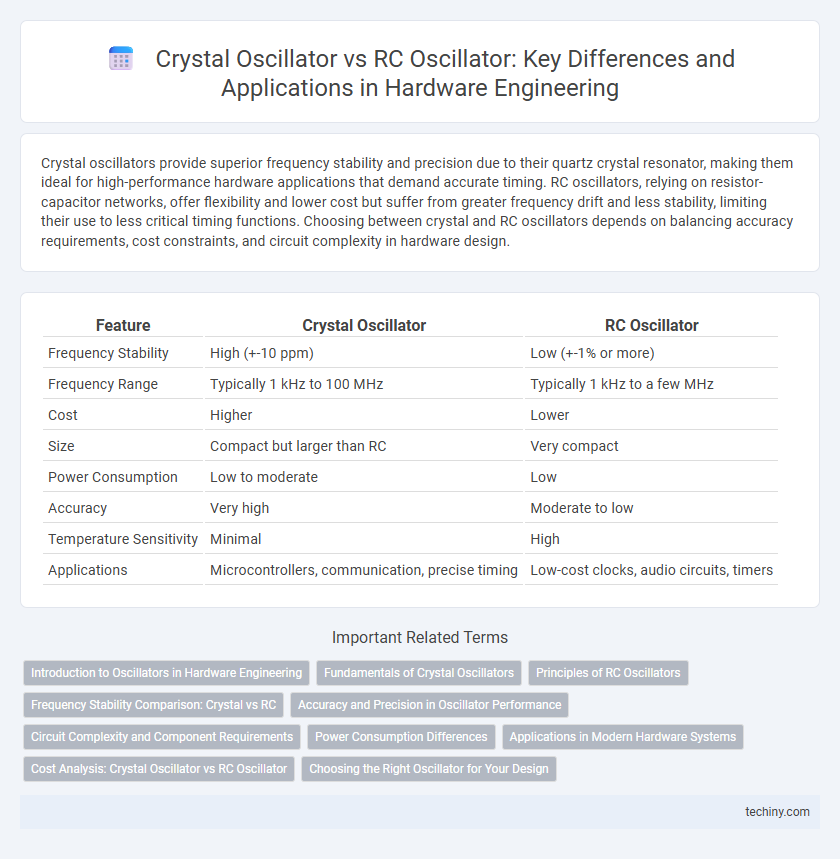Crystal oscillators provide superior frequency stability and precision due to their quartz crystal resonator, making them ideal for high-performance hardware applications that demand accurate timing. RC oscillators, relying on resistor-capacitor networks, offer flexibility and lower cost but suffer from greater frequency drift and less stability, limiting their use to less critical timing functions. Choosing between crystal and RC oscillators depends on balancing accuracy requirements, cost constraints, and circuit complexity in hardware design.
Table of Comparison
| Feature | Crystal Oscillator | RC Oscillator |
|---|---|---|
| Frequency Stability | High (+-10 ppm) | Low (+-1% or more) |
| Frequency Range | Typically 1 kHz to 100 MHz | Typically 1 kHz to a few MHz |
| Cost | Higher | Lower |
| Size | Compact but larger than RC | Very compact |
| Power Consumption | Low to moderate | Low |
| Accuracy | Very high | Moderate to low |
| Temperature Sensitivity | Minimal | High |
| Applications | Microcontrollers, communication, precise timing | Low-cost clocks, audio circuits, timers |
Introduction to Oscillators in Hardware Engineering
Crystal oscillators provide precise and stable frequency generation using piezoelectric quartz crystals, essential for high-accuracy timing in microcontroller clocks and communication systems. RC oscillators rely on resistor-capacitor networks to produce oscillations, offering simplicity and low cost but with less frequency stability and higher temperature sensitivity. Understanding these fundamental differences guides engineers in selecting oscillators based on performance requirements and application constraints in hardware design.
Fundamentals of Crystal Oscillators
Crystal oscillators use piezoelectric quartz crystals to generate highly stable frequencies through mechanical resonance, offering superior precision compared to RC oscillators, which rely on resistors and capacitors for timing signals. The fundamental operation of crystal oscillators hinges on the crystal's natural resonant frequency, determined by its cut and size, providing minimal frequency drift and high Q factor. Their stability and low phase noise make crystal oscillators essential in applications demanding accurate timing, such as microcontrollers and communication systems.
Principles of RC Oscillators
RC oscillators generate oscillations through a combination of resistor-capacitor networks that create phase shifts necessary for sustained sine wave output. The oscillator's frequency is determined by the RC time constant, which is highly adjustable by varying resistance or capacitance values. Compared to crystal oscillators, RC oscillators offer simpler designs and lower cost but exhibit less frequency stability and accuracy due to temperature and component tolerances.
Frequency Stability Comparison: Crystal vs RC
Crystal oscillators exhibit superior frequency stability compared to RC oscillators due to the quartz crystal's high Q-factor and minimal temperature coefficient. RC oscillators suffer from significant frequency drift caused by component tolerances, temperature variations, and aging effects, resulting in less precise output signals. In precision hardware engineering applications, crystal oscillators are preferred for stable, accurate frequency generation over RC oscillators.
Accuracy and Precision in Oscillator Performance
Crystal oscillators offer superior accuracy and precision compared to RC oscillators due to their stable quartz crystal resonators, which provide frequency stability in the range of +-10 ppm or better. RC oscillators rely on resistor-capacitor networks that are more susceptible to variations in temperature and component tolerances, resulting in frequency inaccuracies often exceeding +-1%. The high Q factor of crystal oscillators ensures minimal frequency drift and excellent phase noise performance, making them ideal for applications demanding precise timing.
Circuit Complexity and Component Requirements
Crystal oscillators offer superior frequency stability and precision with minimal component variation, but they require a quartz crystal, adding cost and mechanical sensitivity. RC oscillators have simpler circuit designs using resistors and capacitors, making them cost-effective and easier to integrate but suffer from lower frequency accuracy and stability. The trade-off involves selecting crystal oscillators for high-performance applications and RC oscillators for low-cost, less-critical timing tasks.
Power Consumption Differences
Crystal oscillators exhibit significantly lower power consumption compared to RC oscillators due to their stable frequency and high-quality factor (Q factor) resonators, minimizing energy loss. RC oscillators rely on resistors and capacitors, which inherently dissipate more power through continuous charging and discharging cycles. This difference makes crystal oscillators ideal for low-power applications such as wearable devices and battery-operated hardware systems.
Applications in Modern Hardware Systems
Crystal oscillators provide highly stable and precise frequency references essential for communication devices, microcontrollers, and GPS modules, ensuring accurate timing and synchronization. RC oscillators, with their simpler design and lower cost, are commonly used in applications like audio circuits, clock generation in low-frequency systems, and basic timing functions where ultra-high precision is not critical. Modern hardware systems leverage crystal oscillators for performance-critical tasks requiring frequency stability while employing RC oscillators in cost-sensitive or less frequency-sensitive applications.
Cost Analysis: Crystal Oscillator vs RC Oscillator
Crystal oscillators generally incur higher initial costs due to precise manufacturing and stability components, while RC oscillators offer lower production expenses with simpler circuitry and readily available resistors and capacitors. The long-term cost benefits of crystal oscillators emerge from superior frequency stability, reducing calibration and maintenance requirements compared to RC oscillators prone to drift and environmental sensitivity. Budget allocation in hardware engineering projects typically weighs upfront cost savings against performance and reliability when selecting between crystal and RC oscillators.
Choosing the Right Oscillator for Your Design
Crystal oscillators offer high frequency stability and low phase noise, making them ideal for precision timing applications in hardware engineering. RC oscillators, while less accurate, provide cost-effective solutions with simpler design and faster startup times suitable for general-purpose circuits. Selecting the right oscillator depends on factors such as frequency accuracy, power consumption, cost constraints, and environmental conditions within the hardware design.
Crystal oscillator vs RC oscillator Infographic

 techiny.com
techiny.com